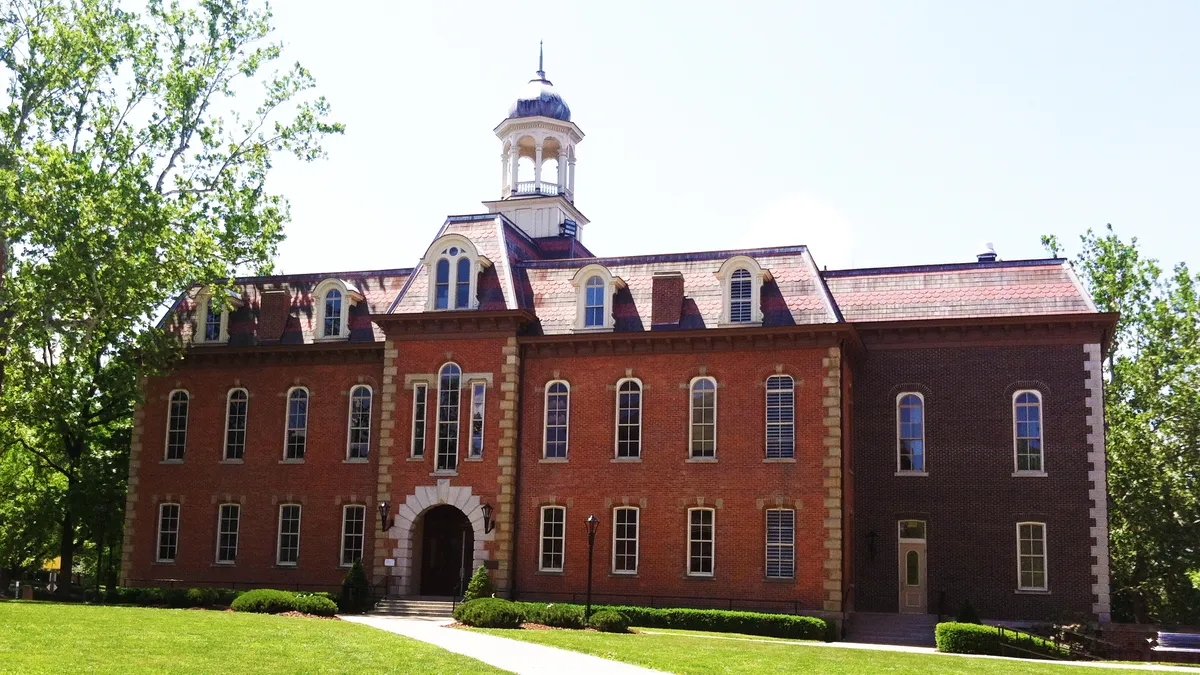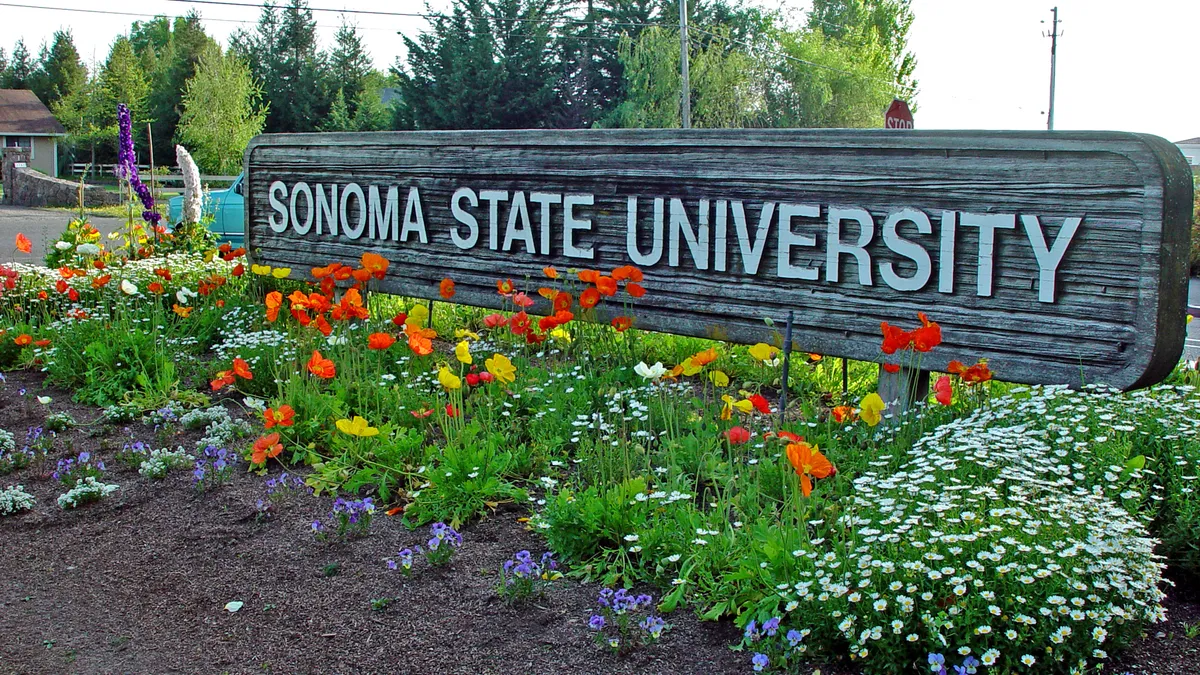West Virginia University announced Wednesday a merger of its College of Creative Arts and the Reed College of Media, heralding it as a “creative and innovative collaboration.”
But in the same breath it cast the consolidation as inventive, it acknowledged it was staring down “a challenging collegiate landscape,” which for the public flagship means an estimated $45 million budget deficit for the coming academic year.
The merger is part of a broader restructuring of the university’s academic programs and finances, which it expects will bring administrative and other cost savings.
This wasn’t the first occasion WVU leaders made the institution’s financial fiasco known. President E. Gordon Gee, in a March address, pointed to headwinds like declining populations of college-age students and rising costs that predated the COVID-19 pandemic.
Policy pundits also primarily blame the budget crunch on anemic state support.
No college has crafted a silver bullet for these problems, which plague significant swaths of higher education. And for WVU, the solution likely will be further cost cutting, at least $75 million’s worth over the next five to seven years amid a projected loss of 5,000 students in the next decade. WVU enrolls more than 24,700 students at its primary campus in Morgantown.
What other austerity measures can we expect from WVU?
WVU spokesperson April Kaull did not respond to a question Thursday about how much money combining the two colleges would save. The move will be presented for the university board of governors’ endorsement next week.
“By bringing together the faculty expertise of both units, WVU can distinguish itself with dynamic programming in areas such as digital media, interactive arts and game design to prepare students for the jobs of today and the careers of tomorrow,” Provost Maryanne Reed said in a statement.
Academic restructuring has been on the table for more than two years, after Gee in 2020 publicly proclaimed the university needed to adapt, in part due to “a loss of public trust” and diminishing public perception of higher education.
Several months later, it started the process of merging two of its colleges to form a new College of Applied Human Sciences. The university is remolding its academic portfolio with help from RPK Group, a consultancy.
As degree programs shrink, faculty jobs are at risk. The university said last month “some faculty” will be dismissed or not have their contracts renewed.
Those faculty members “will be assessed on performance, knowledge, qualifications and seniority,” the university said. It also offered employees options to voluntarily scale back how many hours they work.
Slashing jobs will likely not endear Gee to faculty, who have already scuffled with him. WVU’s chapter of the American Association of University Professors backed a faculty senate resolution of no-confidence against him and Provost Reed in 2021, though it ultimately failed, 20-103.
The two administrators created an “atmosphere of opacity, upheaval, and disregard for stakeholders that harms the mission of the university and compromises its long-term fiscal and institutional health,” the AAUP chapter said at the time.
State budget woes
What’s driving the WVU budget squeeze? According to one policy group, it’s state disinvestment.
The West Virginia Center on Budget and Policy, a nonprofit think tank, recently delved into what it called WVU’s budget crisis.
It found state higher education funding nosedived more than $146 million between fiscal year 2013 and 2024 after adjusting for inflation, amounting to a roughly 24% decline.
Had lawmakers merely maintained inflation-adjusted higher ed funding levels from a decade ago, WVU’s budget gap would be much smaller, the center said.
As state funding has slimmed, West Virginia public colleges pivoted to rely more on tuition revenue, the organization said.
In the past ten years, WVU's tuition rates rose steadily, and research indicates that when a college’s costs rise, some students tend to avoid it.
Such a dynamic has emerged in Pennsylvania. Faculty and administrators in the Pennsylvania State System of Higher Education partially ascribe its falling enrollment to the tuition hikes it pursued in response to sparse state funding.
Gee did not mention middling state aid in his March speech. But then, higher education leaders often hesitate to pin funding woes on lawmakers who control purse strings.
Kaull, the spokesperson, said the university appreciates the state funding it receives each year and that it works “diligently to be good stewards of that financial support.” She said state appropriations this year helped address deferred maintenance, also noting lawmakers set aside $50 million from West Virginia’s budget surplus to bolster the WVU Cancer Institute.
On a national scale, state higher education investments actually improved in 2022 — up nearly 5% from the preceding year, even adjusted for inflation, according to the State Higher Education Executive Officers Association.
SHEEO attributed the trends to an uptick in state money, as well as an influx of federal COVID-19 aid.
It cautioned, though, that the latter funding pool is running dry. And states don’t subsidize public higher ed equally — West Virginia especially falls behind in this regard, according to SHEEO.
More than 20 states allocate at least 80% of funding to public institutions’ general operations budgets, but West Virginia isn’t one of them. It earmarks less than 60%.
Many public colleges are under stress in the uncertain economic environment, even other state flagships. Officials at Rutgers University, in New Jersey, said a roughly $125 million budget deficit was spurred by a significant increase in healthcare costs, declining enrollment, inflation and COVID-19 aid running out.
And Pennsylvania State University forecasts it will cut as many as 50 full-time employees as it tries to remedy an almost $150 million budget gap.
Tom Harnisch, SHEEO’s vice president for government relations, said in an email that he expects more colleges will mull similar cost-cutting measures in the years ahead because of declining enrollment and limited state funding. State flagships won’t be immune to these trends, Harnisch said.
“WV lawmakers had a record budget surplus this year and didn’t make higher education a funding priority,” Harnisch said. “Funding for higher education in West Virginia has long trailed the national average, and combined with the declining enrollment count, put significant pressure on university budgets and led to restructuring efforts.”




















